A traveling epidemiologist and a registered nurse before her retirement, Janet Ives spent many years in the health care industry healing and teaching others. Now her focus is on her own health, specifically her osteoporosis diagnosis, which affects almost every aspect of her daily life. However, thanks to a long-term personalized care plan established by Nahid Rianon, MD, geriatric medicine expert with UT Physicians, Ives is adjusting to her new normal.
An osteoporosis diagnosis
Osteoporosis is a condition classified by weakened bone that breaks with minimal trauma, like a fall from standing height. Oftentimes, patients are unaware they suffer from the disease until they experience an easily broken bone.
Ives was first diagnosed nearly three decades ago. In 2010, she was referred to Rianon, who is also an associate professor in the Department of Family and Community Medicine and the Joan and Stanford Alexander Division of Geriatric and Palliative Medicine at McGovern Medical School at UTHealth.
“After I found Nahid, I knew I would stick with her,” said Ives. “I could tell she had my best interest in mind. I’ve been with her ever since.”
Their first big problem in Ives’ medical journey came in the form of a vertebral fracture. After trying to empty out the trash one day, Ives made one wrong move and was in instant pain. Although the pain was severe, she could still walk.
“After a couple days of rest and taking pain relievers, it didn’t get better. My friend called Nahid who told her to get me to the hospital,” said Ives.
Rianon says vertebral fractures are tricky when it comes to osteoporosis patients because like Ives, they are often still mobile after the incident.

“We hear a lot about the dangers of hip fractures because they usually cause immediate immobility, but a vertebral fracture can often go undetected by patients, leading to the same life-changing issues,” said Rianon. “If something hurts, always get it checked out and treated.”
Ives’ official diagnosis was two fractured vertebrae and low blood sodium, which is common in older adults and can cause confusion. In the hospital, she underwent physical therapy and received medication to manage her pain.
Because she lived alone, Ives could not be discharged home where she would be unable to care for herself with limited mobility. Instead, she was discharged to a skilled nursing facility to aid in her rehabilitation. Unfortunately, after a few days her blood sodium levels were low once again and she was back in the hospital to be stabilized.
Low blood sodium levels are often common in patients admitted with broken bones and typically worsen an osteoporotic bone by increasing calcium loss in the body.
Once Ives was released from the hospital for the final time, she returned home with the assistance of home health and friends.
“Having home health was very helpful. I also had occupational and physical therapy and modified my home to make it safer,” said Ives.
Long-term managed care
Today, Ives is pain-free and lives with her friend for additional assistance in her daily life.
“We all have a very open line of communication, myself, Nahid, and my friend,” said Ives. “If I need something, we can reach out to Nahid directly to update her.”
To alleviate some of her osteoporosis symptoms, Rianon and Ives refined a treatment plan to prevent further bone loss, which includes a biannual injection that works as a bone-modifying agent, vitamin D, calcium, and sodium supplements.
In the near future, Ives plans to move out of state with her caregiver and friend.
“It does make me feel a little sad. We’ve had a long journey together,” said Rianon.
To help Ives in her transition, Rianon is in the process of reaching out to geriatric experts in her new hometown to ensure continuation of care.
Osteoporosis care at UT Physicians
Finding comprehensive and personalized care for an osteoporosis diagnosis can be the key to remaining independent for as long as possible. Ives urges others to take the condition seriously and seek out help from experts.
“It’s not going to go away. It’s permanent and you will need to be careful with every single movement you make,” said Ives. “Don’t wait to contact a specialist.”
The UT Physicians Center for Healthy Aging – Bellaire is home to an osteoporosis program, led by Rianon. For additional information or to schedule an appointment, visit their page.


